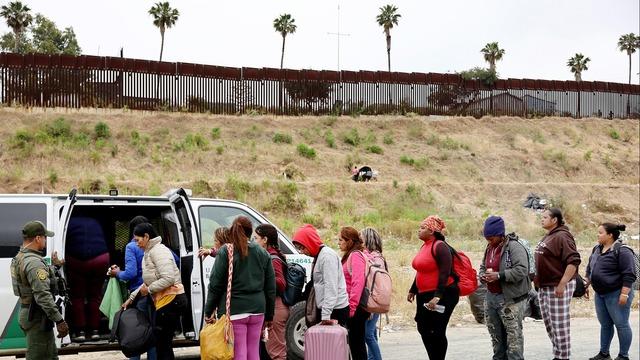▶ Watch Video: Why illegal border crossings dropped 70% since early May
The Department of Homeland Security’s internal watchdog on Wednesday questioned the Border Patrol’s system for determining whether migrants could pose a national security risk due to terrorism ties, calling current procedures “ineffective.”
The report from the Department of Homeland Security’s Office of Inspector General focused on the release of a migrant in 2022 who was later found to be on the FBI’s terrorist watchlist.
Government investigators said Border Patrol agents released the migrant and his family in April 2022 before federal law enforcement officials were able to determine whether he was on the Terrorist Screening Dataset, an FBI system that tracks known or suspected terrorists, as well as their affiliates.
Border Patrol — which is an agency under Customs and Border Protection, a division of DHS — screens migrants it apprehends along land and coastal borders before transferring them to another government agency, deporting them or releasing them so they can await a decision on their immigration cases. Those screenings include reviews of criminal and immigration records, as well as terrorism database searches.
But the DHS inspector general said Border Patrol agents in Arizona released the migrant without waiting for an inconclusive terrorism database search to be resolved. It was not until the migrant checked in to a flight to Florida that federal officials were able to determine the migrant was indeed on the terrorism watchlist.
Two weeks after entering the U.S., the migrant was arrested in Florida by Immigration and Customs Enforcement, or ICE, though that agency also faced several hurdles in obtaining information about his records, according to the DHS watchdog.
“If [Customs and Border Protection’s] ineffective practices for resolving inconclusive Terrorist Watchlist matches continue, the component risks releasing individuals into the United States who potentially threaten national security and public safety,” investigators said in their report.
Reached for comment, DHS criticized the report, saying it “sensationalizes and mischaracterizes a complex case.” The department said Border Patrol and ICE agents had taken “appropriate steps to ensure there was no threat to the public.”
While the report did not name the migrant in question or identify his nationality, it did include a reference to congressional testimony about a Colombian man who was released after entering the U.S. illegally near Yuma, Arizona, when detailing a timeline of the migrant’s case. The information disclosed during the congressional hearing in July 2022 matches the details about the migrant described in the report.
The U.S. government has delisted Colombia’s demobilized leftwing guerillas and rightwing paramilitaries — known as the Revolutionary Armed Forces of Colombia, or FARC in Spanish, and the United Self-Defense Forces of Colombia, respectively — from its list of foreign terrorist groups. But people associated with these groups could still be on the FBI’s terrorism watchlist. Moreover, the U.S. still considers certain armed dissident guerillas in Colombia to be terrorist groups.
According to Wednesday’s report, the migrant at the center of the internal investigation entered U.S. Border Patrol custody near Yuma on April 17, 2022, with family members.
After the FBI failed to determine whether the migrant was on the terror watchlist, it asked the Border Patrol to interview him, investigators said. But CBP officials sent the request to the wrong email address, and the interview did not take place, according to the report. CBP officials, investigators added, later obtained a photo and additional information about the migrant but did not share it with the FBI.
On April 19, the migrant was released from Border Patrol custody, even though the agency and the FBI had not finished the terrorism database search. Border Patrol agents in Yuma told investigators that they released the migrant because of inadequate procedures for handling cases of migrants with inconclusive watchlist searches and because they were under “pressure” to release detainees quickly due to overcrowding in holding facilities.
Before the migrant boarded a plane from Palm Springs, California, to Tampa, Florida, the TSA shared additional information with the FBI that allowed officials there to confirm he was a positive terrorism watchlist match, according to investigators.
After being informed of the watchlist match, ICE “prioritized” the migrant’s arrest, investigators said. However, the report found that ICE had difficulty obtaining information about the migrant to facilitate his arrest, including his immigration records. On May 6, ICE agents stopped the migrant’s vehicle and arrested him.
In response to the report, a DHS official called the findings “misleading,” saying Border Patrol did not know the migrant was on the watchlist when he was released. The official also noted that the migrant was released with a GPS-enabled ankle monitor, which officials used to track his movements. Once the watchlist match was confirmed, ICE “followed procedure and arrested the individual,” the official added.
Border Patrol apprehensions of migrants on the FBI’s terrorism watchlist have increased in recent years as the number of overall crossings along the U.S.-Mexico border have soared to record levels.
Border Patrol has reported apprehending 125 migrants along the U.S.-Mexico border with positive terrorism watchlist matches so far this fiscal year, already above the previous record of 98 set in fiscal year 2022, government figures show. In fiscal year 2021, the agency reported just 15 such apprehensions.
While terrorism watchlist hits have increased, they still represent a very small fraction, or .0089%, of the hundreds of thousands of migrants who have crossed the U.S. southern border illegally this year alone.




































